Problem 1: An object moves from point A to point B to point C, then back to point B and then to point C along the line shown in the figure below.
a) Find the distance covered by the moving object.
b) Find the magnitude and direction of the displacement of the object.

Solution to Problem 1:
a) distance = AB + BC + CB + BC = 5 + 4 + 4 + 4 = 17 km
b) The magnitude of the displacement is equal to the distance between the final point C and the initial point A = AC = 9 km
The direction of the displacement is the direction of the ray AB.
Problem 2: An object moves from point A to point C along the rectangle shown in the figure below.
a) Find the distance covered by the moving object.
b) Find the magnitude of the displacement of the object.
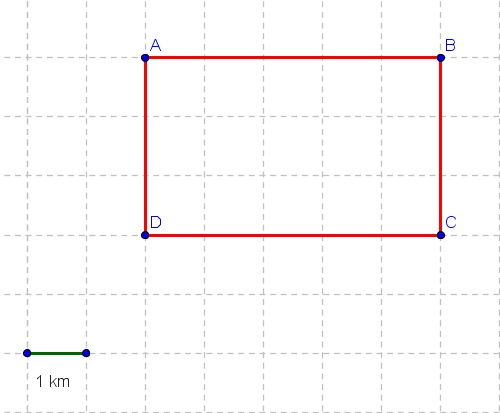
Problem 3: An object moves from point A to B to C to D and finally to A along the circle shown in the figure below.
a) Find the distance covered by the moving object.
b) Find the magnitude and direction of the displacement of the object.
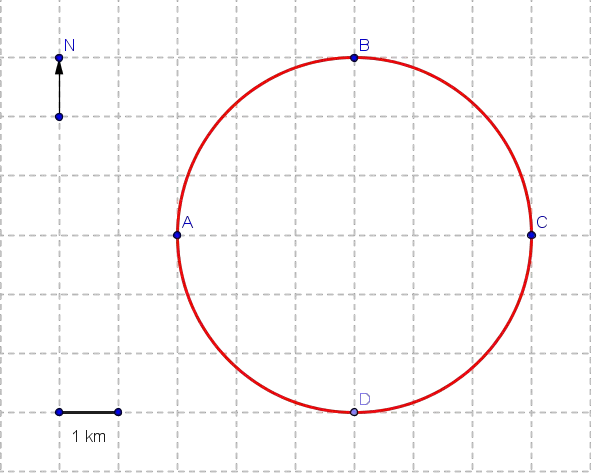
Solution to Problem 3:
a) The object moves one complete rotation and therefore the distance d is equal to the circumference and is given by
d = 2 Pi * radius = 6 Pi km
b) Initial point is A and the final point is A, no change in position; hence the magnitude of the displacement is equal to zero
Problem 4: An object moves from point A to B to C to D along the circle shown in the figure below.
a) Find the distance covered by the moving object.
b) Find the magnitude of the displacement of the object.
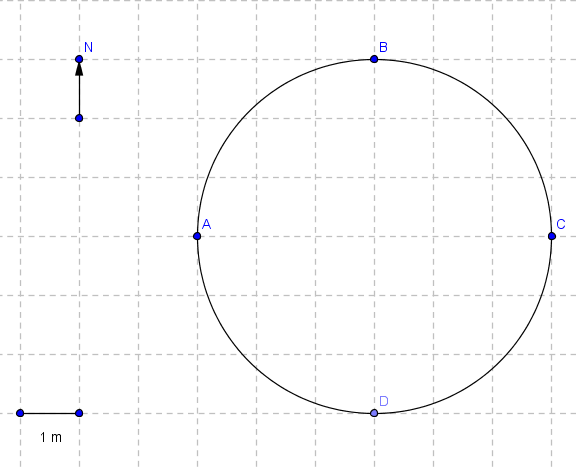
Problem 5: An object moves along the grid through the points A, B, C, D, E, and F as shown below.
a) Find the distance covered by the moving object.
b) Find the magnitude of the displacement of the object.
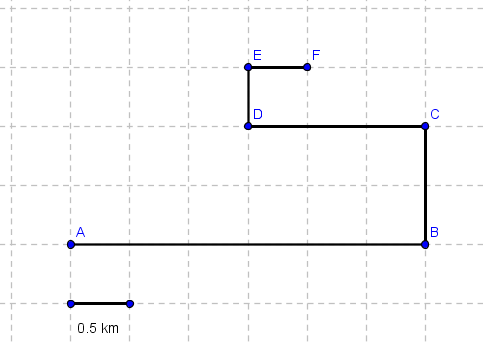
Solution to Problem 5:
a) distance = AB + BC + CD + DE + EF = 3 + 1 + 1.5 + 0.5 + 0.5 = 6.5 km
b) Initial point is A and the final point is F, hence the magnitude of the displacement is equal to the distance AF which is calculated by applying Pythagora's theorem to the triangle AHF as shown in the figure below
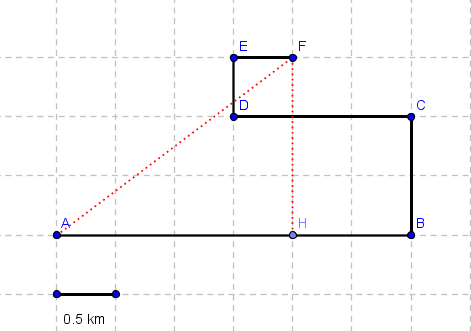
www.dpisd.org/.../Distance-Displacement-Velocity%20Practice%20Probl...-
http://www.newarkcatholic.org/wp-content/uploads/2014/10/Distance-and-Displacement-Pkt-Key.pdf
http://www.problemsphysics.com/mechanics/motion/velo_spe_solutions.html
Q6)At an average speed of 24km/h how many kilometres will a cyclist travel in 75minutes?
Q7) A sprinter starting from the blocks reaches his full speed of 9m/s in 1.5s . What is his average acceleration?
EQUATIONS
OF MOTION
1. v= u+at
2. s = ut +1/2 at2
3. v2 = u2
+ 2aS
U=
initial velocity
V=final
velocity
Vav
= Average velocity
a=
acceleration
s=
displacement
t =
time
Derive v = u+at
By definition
acceleration=change in velocity/time
acceleration=change in velocity/time
a =( v-u)/t cross multiplying
at =
v-u rearranging
v =
u + at
Derive
s = ut +1/2 at2
By definition,
average velocity = displacement/time
Vav = s/t
There fore s = Vav x t
---- eq. 1
average velocity is also equal to
Vav = (u+v)/2----
eq. 2
Vav = {u+(u+at)}/2 = (2u+at)/2 ------eqn.3
comparing eqns 1 and 3
Vav = s/t
=(2u+at)/2
cross multiplying 2s= 2ut + at2
s=( 2ut+at2 )/2 =
ut+1/2 a t2
s = ut+1/2 a t2
Derive v2 = u2 + 2aS
By definition
average velocity = displacement/time
Vav =
s/t-- eqn1
Also average velocity Vav = (u+v)/2 --------- eqn 2
comparing eqns 1 and 2 s/t =(u+v)/2
cross multiplying 2 x S =t x (u+v)
2S = (v-u)/a x (u+v)
2s = (v2
- u2)/across multiplying
v2-
u2 = 2aS
v2
= u2 +2aS
EQUATIONS OF MOTION
Problemshttp://www.physicsclassroom.com/class/1DKin/Lesson-6/Sample-Problems-and-Solutions
FREE FALL -Abody which isfalling freely only under the force of gravity is said to be in free fall.
g = 9.8m/s2
a= +9.8m/s2 if the body is falling down and
a = -9.8m/s2 if the body is going up
Q10) A stone is thrown up with a speed of
4m/s. calculate
a)how high it will rise and
b) the time taken for reaching the maximum
height.(g=9.8m/s2)
Q11) A stone thrown up reaches the maximum height
in 5seconds.
Calculate the velocity with which it is thrown up
and the height it has reached.
Q12) A cricketer throws a ball vertically upward in
to the air with an
initial velocity of 18m/s.
a)How high will it rise?
b)After how long will it return to the cricketer's
hand?
Q13) A cricket ball is thrown vertically upwards
with a speed of 15m/s.
What is the velocity when it passes throuh a point
8m bove the cricketers
hand?Q14)
Q15)
https://www.khanacademy.org/math/cc-eighth-grade-math/cc-8th-linear-equations-functions/8th-slope/v/slope-of-a-line
http://farside.ph.utexas.edu/teaching/301/lectures/node20.html
http://www.physicsclassroom.com/morehelp/graphs
Area under velocity -Time graph gives displacement.
Q16)Calculte the displacement of the body from the velocity -time graph given below.
Q17)The velocity -Time graph of a body is given below. Calculate the total distance and the displacement of the body
The area under the velocity - time graph gives the displacement
Q18) The graph shows the motion of a lift starting at rest and initially moving upwards.
b) How high is the lift above the starting point at C?
c) What happens to the lift between Band C?
d) What happens to the lift between Dand F?
e) What is the acceleration of the lift between O and A?
Q19)
Q20) The figure below shows the velocity - time graph of a body.
1) OA
2) AB
3) BC
4) CD
5) DE
b) The upward deceleration of the lift
c) the distance the lift moved in the upward direction
d) the distance the lift moved in the downward direction
e) Total distance covered
f) displacement of the lift
Q21)
 |
DERIVING EQUATIONS OF MOTION
http://www.physicsclassroom.com/class/vectors/Lesson-2/What-is-a-Projectile
http://www.physicsclassroom.com/class/vectors/Lesson-2/What-is-a-Projectile









































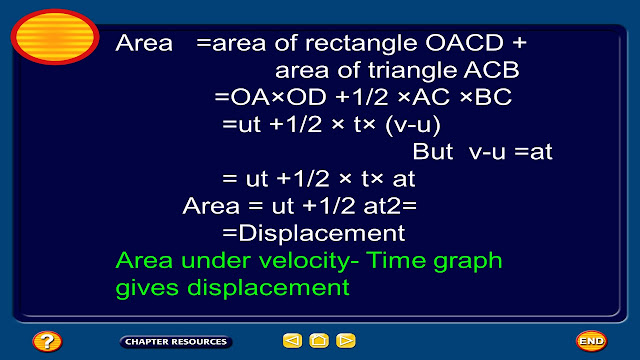
























No comments:
Post a Comment